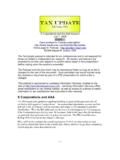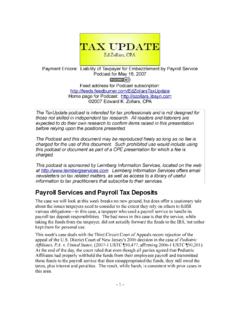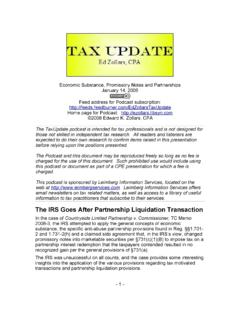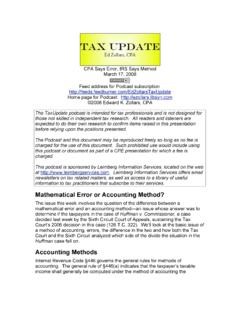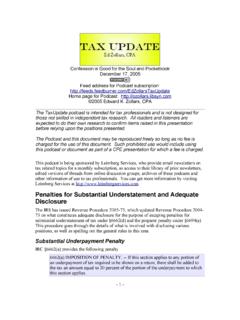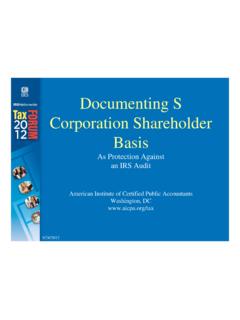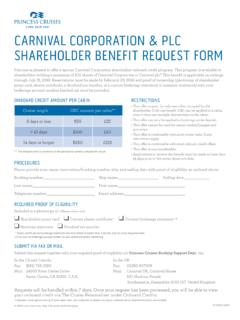Transcription of S Corporation Debt Revisited - Ed Zollars
1 S Corporation debt and How To Not End Up With BasisNovember 3, 2008 Feed address for Podcast subscription: page for Podcast: 2008 Edward K. Zollars , CPAThe TaxUpdate podcast is intended for tax professionals and is not designed for those not skilled in independent tax research. All readers and listeners are expected to do their own research to confirm items raised in this presentation before relying upon the positions presented. The Podcast and this document may be reproduced freely so long as no fee is charged for the use of this document. Such prohibited use would include using this podcast or document as part of a CPE presentation for which a fee is podcast is sponsored by Leimberg Information Services, located on the web at Leimberg Information Services offers email newsletters on tax related matters, as well as access to a library of useful information to tax practitioners that subscribe to their Corporation debt RevisitedWe stay on the same basic issue we talked about last time, except this time we don't look at new revised rules that can get clients into tax hot water, but rather this time at taxpayers that managed to run afoul of rules that had been in place for quite a while.
2 We at the Tax Court's decision in the case of Russell v. Commissioner, TC Memo 2008-246, where taxpayers managed to demonstrate multiple ways to be effectively on the hook for debt , but still be unable to use that debt to claim S Corporation Corporation debt basis RulesThe ability to claim a pass through loss from an S Corporation depends on having sufficient basis to claim such losses. In 1366(d)(1) we find the general rules for limiting the deduction of losses. The provisions begins by telling us that the loss allowed for a shareholder for a year cannot exceed the sum of two items. The first of these involves the stock of the company held by the shareholder, and the limit there is defined as: - 1 -S Corporation debt and How To Not End Up With BasisPodcast of November 3, 2008 (A) the adjusted basis of the shareholder's stock in the S Corporation (determined with regard to paragraphs (1) and (2)(A) of section 1367(a) for the taxable year), and As noted, we find the general rules for stock basis in 1367(a).
3 However, unlike a partnership, the basis in the ownership interest is not increased by a taxpayer's share of the debt , even if that is one that is fully recourse as far as the shareholder is concerned. Rather in the S Corporation we look towards debt from the shareholder to the Corporation . The definition of that debt is found at 1366(d)(1)(B) which reads: (B) the shareholder's adjusted basis of any indebtedness of the S Corporation to the shareholder (determined without regard to any adjustment under paragraph (2) of section 1367(b) for the taxable year).The key issue is that debt must be from S Corporation to the shareholder. And the case law makes it clear that close doesn't count for these purposes so debt guaranteed by the shareholder or debt from another entity the shareholder controls doesn't today's case we will see two different ways these taxpayers managed to foul up handling the debt to the Corporation that creates a problem for of DebtsThe case involved two couples the Russells and the Kopsengs, who resided in North Dakota and had interests in a number of entities.
4 The key one of interest in this case is Missouri River Royalty Corp., an S Corporation until it terminated its election voluntarily effective September 1, 1997, when its shares were transferred by the above shareholders to United Energy Corporation in a transaction that qualified under IRC 351. Interests in other businesses were also transferred at that time. The Tax Court noted that nothing in the documentation of the 351 discussed assumption of debts to the shareholders as part of this were a number of notes involved in the transaction. The Court deals with the facts surrounding them in orderBNC NotesMissouri River Royalty Corporation borrowed funds from BNC in the first note in question. The Tax Court outlines the inception of this loan: On or about August 16, 1996, BNC National Bank (BNC) lent $1 million to MRRC. MRRC used the proceeds of the loan to pay off certain prior loans that - 2 -S Corporation debt and How To Not End Up With BasisPodcast of November 3, 2008 been incurred to purchase and rework oil wells.
5 In consideration for the loan, MRRC gave BNC a promissory note for $1 million (MRRC note) and entered into a loan early 1997 (well before the S election was terminated) the loans were reworked. The revised loans are noted below: On January 3, 1997, BNC canceled the MRRC note in consideration for (1) a $463,968 promissory note which Mr. Russell cosigned (the MRRC/DR note), and (2) a $463,968 promissory note which Mr. Kopseng cosigned (the MRRC/LK note). Mr. Russell and Mr. Kopseng also indicated that they intended to guarantee the MRRC/DR note and the MRRC/LK MRRC/DR note and the MRRC/LK note both listed MRRC as the borrower and indicated that they were for the renewal of the MRRC Court notes that all payments on this loan through the September 1, 1997 effective date of the 351 incorporation transaction were made by MRRC. On September 3, 1997 the balance of the note was paid off by MRRC, and all interest that was due at that time was reported on the consolidated tax return for the newly formed parent well, neither couple reported interest income from MRRC related to this and Kopseng Ledger DebtThe next debt considered is one the Tax Court called the Russell and Kopseng Ledger debt .
6 Mr. Russell's debt is described as follows: Before April 5, 1996, Mr. Russell made a series of cash advances to MRRC which MRRC used for working capital (the Russell ledger debt ). As of April 5, 1996, the principal balance of these advances totaled $562,705. In MRRC s books, the Russell ledger debt was recorded as a liability in a ledger account entitled Notes Payable Russell (the notes payable Russell account).On April 5, 1996, MRRC issued a $562,705 note to Mr. Russell for the Russell ledger debt (the Russell ledger debt note). As of September 1, 1997, the principal balance of the Russell ledger debt was $65, similar loan account existed for Mr. Kopseng as noted below: Before April 5, 1996, Mr. Kopseng made a series of cash advances to MRRC which MRRC used for working capital (the Kopseng ledger debt ). As of April 5, 1996, the principal balance of these advances totaled $611,144.
7 In MRRC s - 3 -S Corporation debt and How To Not End Up With BasisPodcast of November 3, 2008 , the Kopseng ledger debt was recorded as a liability in a ledger account entitled Notes Payable Kopseng (the notes payable Kopseng account).On April 5, 1996, MRRC issued a $611,144 note to Mr. Kopseng for the Kopseng ledger debt (the Kopseng ledger debt note). As of September 1, 1997, the principal balance of the Kopseng ledger debt was $117, Court then goes on to describe these notes in more detail: The Russell ledger debt and the Kopseng ledger debt were demand obligations. Interest on the Russell ledger debt and the Kopseng ledger debt was calculated using monthly compounding. There was no requirement that interest accruing on the Russell ledger debt and Kopseng ledger debt be paid at least NoteRainbow Energy Marketing Corporation was another entity owned by Mrs.
8 Russell and Kopseng, shares of which were eventually transferred to United Energy Corporation in the 351 transaction. This entity was also involved in loaning money to MRRC. The Court begins by noting: REMC lent MRRC $57,000 on April 1, 1996, and $37,000 on April 11, 1996 (REMC ledger debt ). MRRC used the REMC ledger debt for working capital. In MRRC s books, the REMC ledger debt was recorded as a liability in a ledger account entitled Notes Payable Kopseng/Russell Partnership. The REMC ledger debt was a demand obligation. There was no requirement that interest accruing on the REMC ledger debt be paid at least note was prepared in connection with the REMC ledger debt (the REMC note). The REMC note stated, in part, that Effective April 1, 1996, Missouri River Royalty Corporation promises to pay Kopseng/Russell Partnership $94, at an interest rate of the applicable Federal Rate Table.
9 Interest on the REMC ledger debt was in fact calculated at a rate that varied from the Wall Street Journal Prime Rate plus 1 percent to the Wall Street Journal Prime Rate plus 2 percent. Interest on the REMC ledger debt was calculated using monthly compounding. At all times, the rates used to calculate interest on the REMC ledger debt exceeded the short-term, monthly-compounding Applicable Federal Rate as then in effect. There was no requirement that interest accruing on the REMC ledger debt be paid at least the effective date of the S termination, the following entries were made on - 4 -S Corporation debt and How To Not End Up With BasisPodcast of November 3, 2008 's books: On June 30, 1998, an adjusting journal entry to MRRC s books reclassified $22,042 of the $75,750 balance of the REMC ledger debt to the notes payable Russell account and $53,708 of the balance to the notes payable Kopseng account.
10 The adjusting journal entry allocated the balance of the REMC ledger debt between the notes payable Russell account and the notes payable Kopseng account in proportion to the interests held by Mr. Russell and Mr. Kopseng in REMC at the time the loans were made in April of Term debt from RGC PartnershipFinally there's a debt referred to as the Short-Term debt by the Court, a debt that was received from and paid to Rainbow Gas Company, a Partnership that was also owned by Mr. Russell and Kopseng. That partnership also became part of the September 1, 1997 Section 351 Court noted: The loans making up the short-term debt were transferred directly from the checking account of RGC Partnership to the checking account of MRRC. The repayments were transferred directly from the checking account of MRRC to the checking account of RGC Partnership. Before August 31, 1997, the short term debt was recorded in MRRC s books as a liability in a ledger account entitled Notes Payable RGC.
